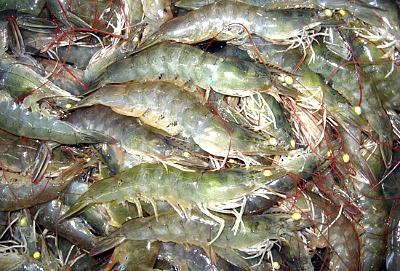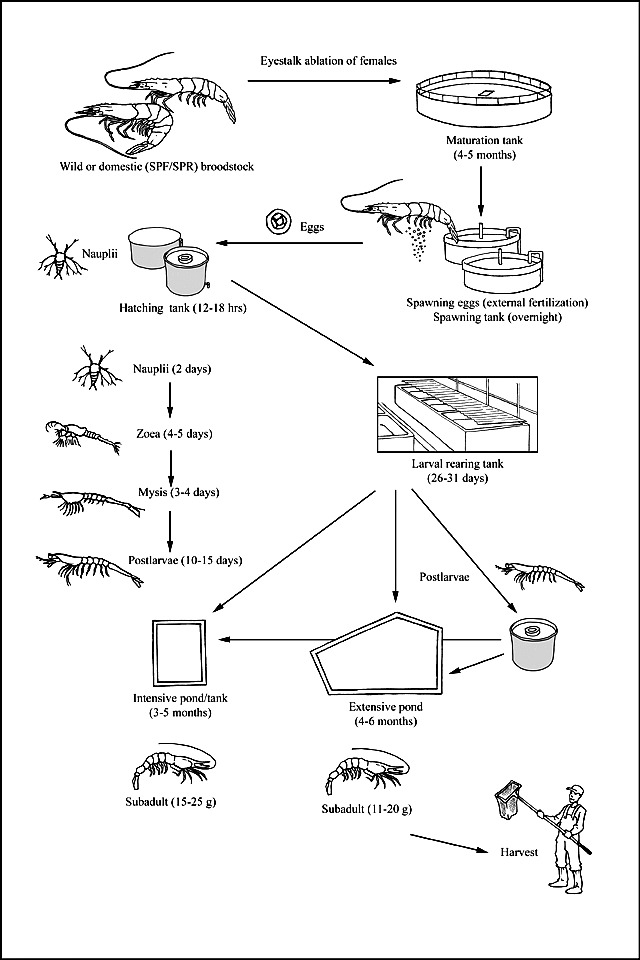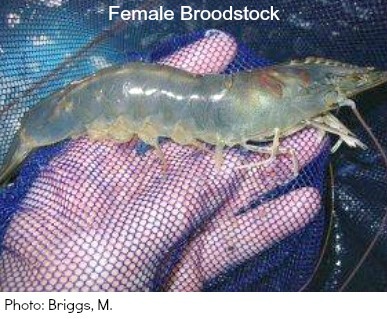 Whiteleg Shrimp (Litopenaeus vannamei, formerly Penaeus vannamei) of the family Penaeidae, also known as the Pacific white shrimp, is an expensive and exotic variety of shrimps from the eastern Pacific Ocean commonly caught or cultured for food.
Whiteleg Shrimp (Litopenaeus vannamei, formerly Penaeus vannamei) of the family Penaeidae, also known as the Pacific white shrimp, is an expensive and exotic variety of shrimps from the eastern Pacific Ocean commonly caught or cultured for food.
HABITAT AND BIOLOGY
The whiteleg shrimp is native to the Eastern Pacific coast from Sonora, Mexico in the North, through Central and South America as far South as Tumbes in Peru, in areas where water temperatures are normally >20 °C throughout the year. L.vannamei live in tropical marine habitats. Adults live and spawn in the open ocean, while postlarvae migrate inshore to spend their juvenile, adolescent and sub-adult stages in coastal estuaries, lagoons or mangrove areas. Males become mature from 20 g and females from 28 g onwards at the age of 6–7 months. L.vannamei weighing 30–45 g will spawn 100 000–250 000 eggs of approximately 0.22 mm in diameter. Hatching occurs about 16 hours after spawning and fertilization. The first stage larvae, termed nauplii, swim intermittently and are positively phototactic. Nauplii do not feed, but live on their yolk reserves. The next larval stages (protozoea, mysis and early postlarvae respectively) remain planktonic for some time, eat phytoplankton and zooplankton, and are carried towards the shore by tidal currents. The postlarvae (PL) change their planktonic habit about 5 days after molting into PL, move inshore and begin feeding on benthic detritus, worms, bivalves and crustaceans.
PRODUCTION CYCLE

PRODUCTION SYSTEMS
Seed Supply
Captured wild seeds were used in Latin America for extensive pond culture of Litopenaeus vannamei until the late 1990s. Domestication and genetic selection programs then provided more consistent supplies of high quality, disease free and/or resistant PL, which were cultured in hatcheries. Some were shipped to Hawaii in 1989, resulting in the production of SPF and SPR lines, leading to the industry in the United States of America and Asia.
Broodstock maturation, Spawning and Hatching
There are three sources for brood stock Litopenaeus vannamei:
- Where they occur naturally, brood stock are sea-caught (usually at 1 year of age and weighing >40 g) and spawned.
- Cultured shrimp harvested from ponds (after 4–5 months at 15–25 g), are on-grown for 2–3 months and then transferred to maturation facilities at >7 months of age when they weigh 30–35 g.
- Purchased from tank-reared SPF/SPR brood stock from the United States of America, (at 7–8 months of age and weighing 30–40 g).
Brood stock are stocked in maturation tanks in dark rooms supplied with clean, filtered seawater. Feeds consist of a mixture of fresh and formulated brood stock feeds. One eyestalk from each female is ablated, leading to repeated maturation and spawning. Females of 8–10 months of age reproduce effectively, whilst males peak at >10 months. Spawning rates of 5–15 percent/night are achieved, depending upon brood stock source. Females are either spawned in communal or individual tanks (to avoid disease transmission). The following afternoon, the healthy nauplii are attracted by light, collected and rinsed with seawater. They are then disinfected with iodine and/or formalin, rinsed again, counted and transferred to holding tanks or directly to larval rearing tanks.

Hatchery Production
Hatchery systems range from specialized, small, unsophisticated, often inland, backyard hatcheries to large, sophisticated and environmentally controlled installations, together with maturation units. Nauplii are stocked into flat, or preferably ‘V’ or ‘U’ shaped tanks with a volume of 4–100 m³, made from concrete, fiberglass or other plastic lined material. The larvae are either cultured to PL10–12 in a single larval rearing tank, or harvested at PL4–5 and transferred to flat-bottomed raceways/tanks and reared to PL10–30. Survival rates to PL10–12 should average >60 percent. Water is exchanged regularly (at 10–100 percent daily) to maintain good environmental conditions. Feeding normally consists of live food (microalgae and Artemia), supplemented by micro-encapsulated, liquid or dry formulated diets. From hatching, it takes about 21 days to reach harvest at PL12. Care is taken to reduce bacterial/pathogen contamination of the larval facilities using a combination of periodic dry-outs and disinfections, inlet water settlement, filtration and/or chlorination, disinfection of nauplii, water exchange and the use of antibiotics or (preferably) probiotics.
Nursery
Most farming operations for L. vannamei do not use nurseries, but transport PL10–12 at reduced temperature either in plastic bags or oxygenated transportation tanks to the pond and introduce them directly. In some instances, nursery systems are used and comprise separate concrete nursery tanks or earth ponds, or even net pens or cages located within production ponds. Such nursery systems may be used for 1–5 weeks. Nurseries are useful in colder areas with limited growing seasons, where PL are nursed to a larger size (0.2–0.5 g) in heated tanks/ponds, before stocking into ponds. The use of super-intensive, temperature-controlled, greenhouse-enclosed, concrete or lined raceways have given good results in the United States of America.
On-growing Techniques
On-growing techniques can be sub-divided into four main categories: extensive, semi-intensive, intensive and super-intensive, which represent low, medium, high and extremely high stocking densities respectively.
1. Extensive
Commonly found in Latin American countries, extensive grow-out of L. vannamei is conducted in tidal areas where minimal or no water pumping or aeration is provided. Ponds are of irregular shape, usually 5–10 ha (up to 30 ha) and 0.7–1.2 m deep. Originally, wild seeds entering the pond tidally through the gate, or purchased from collectors were used; since the 1980s hatchery reared PL are stocked at 4–10/m². Shrimp feed mainly on natural foods enhanced by fertilization, and once-daily feeding with low protein formulated diets. Despite low stocking densities, small shrimp of 11–12 g are harvested in 4–5 months. The yield in these extensive systems, is 150–500 kg/ha/crop, with 1–2 crops per year.
2. Semi-intensive
Semi-intensive ponds (1–5 ha) are stocked with hatchery-produced seeds at 10–30 PL/m²; such systems are common in Latin America. Regular water exchange is by pumping, pond depth is 1.0–1.2 m and aeration is at best minimal. The shrimp feed on natural foods enhanced by pond fertilization, supplemented by formulated diets 2–3 times daily. Production yields in semi-intensive ponds range from 500–2 000 kg/ha/crop, with 2 crops per year.
3. Intensive
Intensive farms are commonly located in non-tidal areas where ponds can be completely drained, dried and prepared before each stocking, and are increasingly being located far from the sea in cheaper, low salinity areas. This culture system is common in Asia and in some Latin American farms that are trying to increase productivity. Ponds are often earthen, but liners are also used to reduce erosion and enhance water quality. Ponds are generally small (0.1–1.0 ha) and square or round. Water depth is usually >1.5 m. Stocking densities range from 60–300 PL/m². Heavy aeration at 1 HP/400–600 kg of harvested shrimp is necessary for water circulation and oxygenation. Feeding with artificial diets is carried out 4–5 times per day. FCRs are 1.4–1.8:1.
Since the outbreak of viral syndromes, the use of domesticated disease free (SPF) and resistant (SPR) stocks, implementation of biosecurity measures and reduced water exchange systems have become commonplace. However, feed, water exchange/quality, aeration and phytoplankton blooms require carefully monitoring and management. Production yields of 7–20 000 kg/ha/crop, with 2–3 crops per year can be achieved, up to a maximum of 30–35 000 kg/ha/crop.
In the ‘bacterial floc’ system, the ponds (0.07–1.6 ha) are managed as highly aerated, recirculating, heterotrophic bacterial systems. Low protein feeds are fed 2–5 times per day, in an effort to increase the C:N ratio to >10:1 and divert added nutrients though bacterial rather than algal pathways. Stocking at 80–160 PL/m², the ponds become heterotrophic and flocs of bacteria are formed, which are consumed by the shrimp, reducing dependence on high protein feeds and FCR and increasing cost efficiency. Such systems have realized productions of 8–50 000 kg/ha/crop in Belize and Indonesia.
4. Super-intensive
Recent research conducted in the United States of America has focused on growing L. vannamei in super-intensive raceway systems enclosed in greenhouses, using no water exchange (only the replacement of evaporation losses) or discharge, stocked with SPF PL. They are thus biosecure, eco-friendly, have a small ecological footprint and can produce cost-efficient, high quality shrimp. Stocking 282 m² raceways with 300–450 0.5–2 g juveniles/m² and ongrowing for 3–5 months has realized production of 28 000–68 000 kg/ha/crop at growth rates of 1.5 g/week, survivals of 55–91 percent, mean weight of 16–26 g and FCRs of 1.5–2.6:1.
Feed Supply
Litopenaeus vannamei are very efficient at utilizing the natural productivity of shrimp ponds, even under intensive culture conditions. Additionally, feed costs are generally less for L. vannamei than the more carnivorous P. monodon, due to their lower requirement for protein (18–35 percent compared to 36–42 percent), especially where bacterial floc systems are used. Feed prices for L. vannamei range from USD 0.6/kg in Latin America and Thailand to USD 0.7–1.1/kg elsewhere around Asia; FCRs of 1.2–1.8:1 are generally obtained.
Harvesting Techniques
Extensive and semi-intensive ponds are harvested by draining the pond at low tide through a bag net installed in the outlet sluice gate. If the tide does not allow harvesting, the water can be pumped out. In some larger farms, harvesting machines pump shrimp and water up to the pond bank where they are dewatered. Intensive ponds may be harvested similarly and small 2–6 man seine nets are dragged around the pond to corral shrimp to the side of the pond from where they are removed by cast or dip net or perforated buckets.
Partial harvesting is common in Asian intensive culture after the first 3 months. In Thailand, artificial sluice gates are temporarily installed inside one corner of the pond to harvest closed system ponds. Shrimp are then trapped in nets attached to this temporary gate when the pond is pumped out.
In super-intensive systems, the shrimp are simply harvested with large scoop nets when required for processing.
Handling and Processing
If shrimp are sold directly to processing plants, specialized teams for harvesting and handling are commonly used to maintain shrimp quality. After sorting, shrimp are washed, weighed and immediately killed in iced water at 0–4 °C. Often sodium metabisulphate is added to the chilled water to prevent melanosis and red-head. Shrimp are then kept in ice in insulated containers and transported by truck either to processing plants or domestic shrimp markets. In processing plants, shrimp are placed in iced bins and cleaned and sorted according to standard export sizes. Shrimp are processed, quickly frozen at -10 °C and stored at -20 °C for export by ship or air cargo. Due to an increasing demand, no taxes and higher profit margins, many processing plants operate value-added product lines.
DISEASES AND CONTROL MEASURES
Diseases
- White spot (WSD); also known as WSBV or WSSV – Acutely infected shrimp show reduced food consumption; lethargy; high mortality of 100% within 3–10 days of onset of clinical signs; loose cuticles with white spots of 0.5–2.0 mm diameter, most apparent inside the carapace; moribund shrimp often have pink to reddish-brown coloration due to expansion of cuticular chromatophores & few if any white spots.
- Taura Syndrome (TS); also known as Taura syndrome Virus (TSV) or red tail disease – Occurs during single molt in juvenile shrimp beginning 5–20 days after stocking, or has a chronic course over several months; weakness, soft shell, empty gut & diffuse expansion of red chromatophores in appendages; mortality varies 5–95%; survivors may have black lesions, & remain carriers for life.
- Infectious Hypodermal & Haematopoietic necrosis (IHHNV), causing Runt Deformity Syndrome (RDS) – Low mortality for resistant P. vannamei; however, reduced feeding, growth & feed efficiency; cuticular deformities (bent rostrum – RDS) occurs in <30% of infected populations, increasing variance of final harvest weight & reducing market value.
- Baculoviral Midgut Gland Necrosis (BMN); also known as midgut gland cloudy disease, white turbid liver disease, & white turbidity disease – Infects larval & early PL stages, causing high mortality; white turbidity of hepatopancreas caused by necrosis of tubule epithelium; larvae float inactively on surface; later stages show resistance; positive brood stock are source of infection.
- Vibriosis – May cause various important syndromes, such as luminescence & the so-called zoea-2 & bolitas syndromes In hatchery; seen as luminescence in water &/or shrimp body; disruption of gut; fouling of body; reduced feeding & high mortality. In ponds, high levels of vibrios are associated with red discoloration of shrimp (especially tails) & internal & external necrosis; low feeding & chronic mortality; often a secondary infection resulting from poor environmental management; weakens shrimp which become susceptible to viral infections
The availability of SPF and SPR brood stock provide a means of avoiding these diseases, although biosecurity procedures are also important, including:
- Thorough drying/scraping of pond bottoms between cycles.
- Reducing water exchange and fine screening of any inlet water.
- Use of bird netting or scarers.
- Putting barriers around ponds.
- Sanitary procedures.
Once viruses do enter the ponds, there are no chemicals or drugs available to treat the infections, but good management of pond, water, feed and the health status of stocks can reduce their virulence.
Source: www.fao.org; Photos: www.auburn.edu; www.fao.org